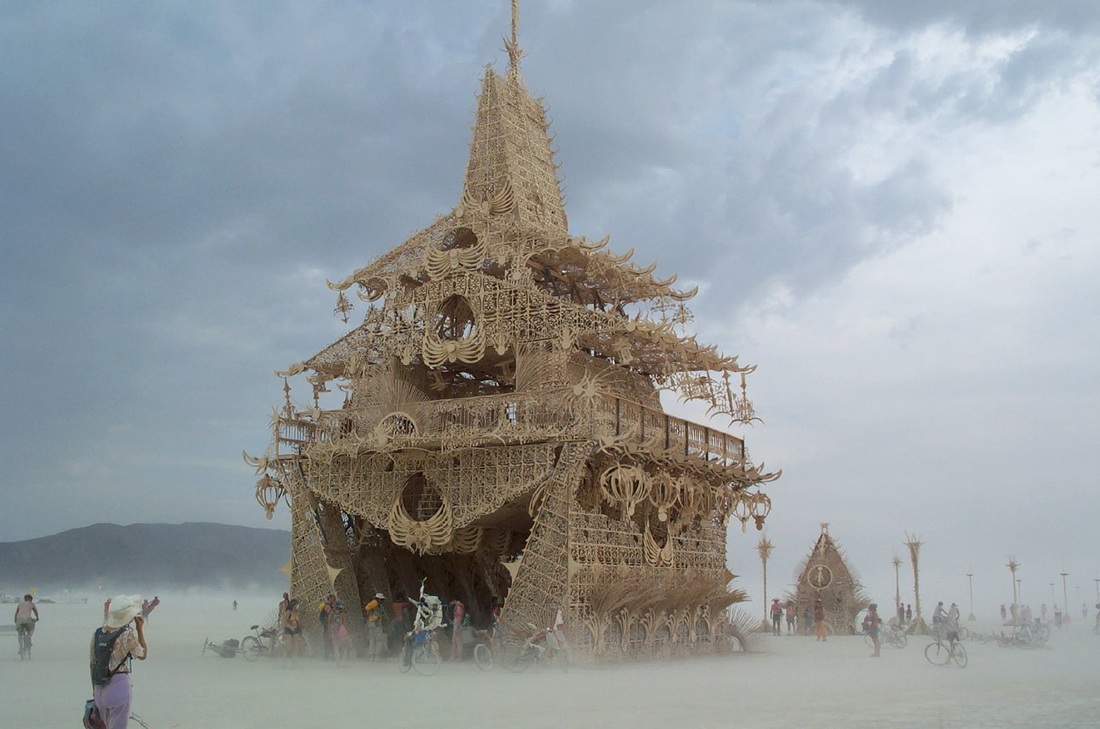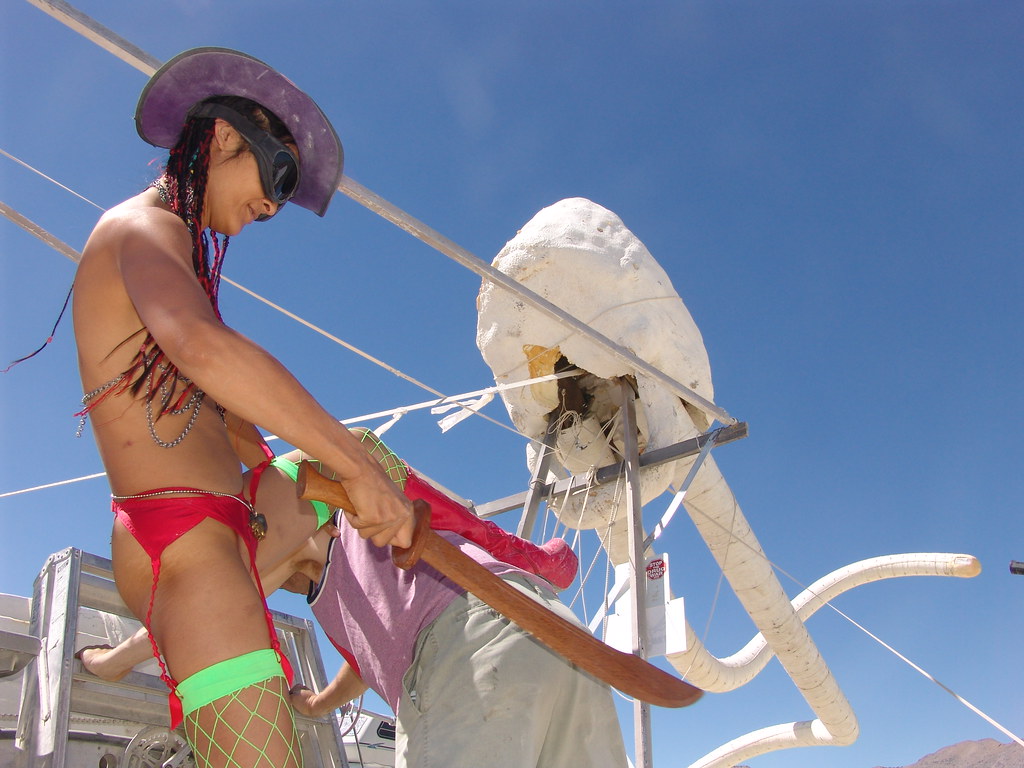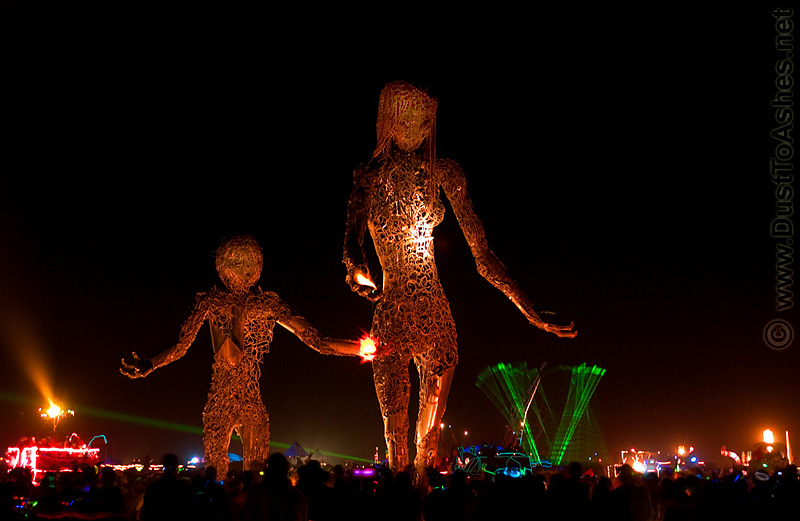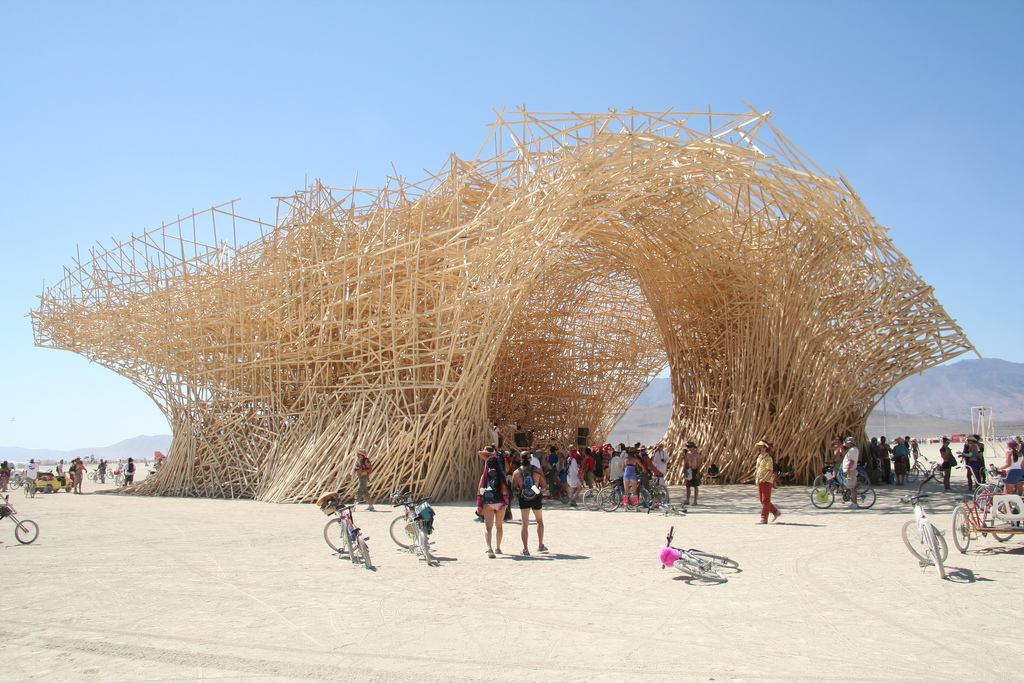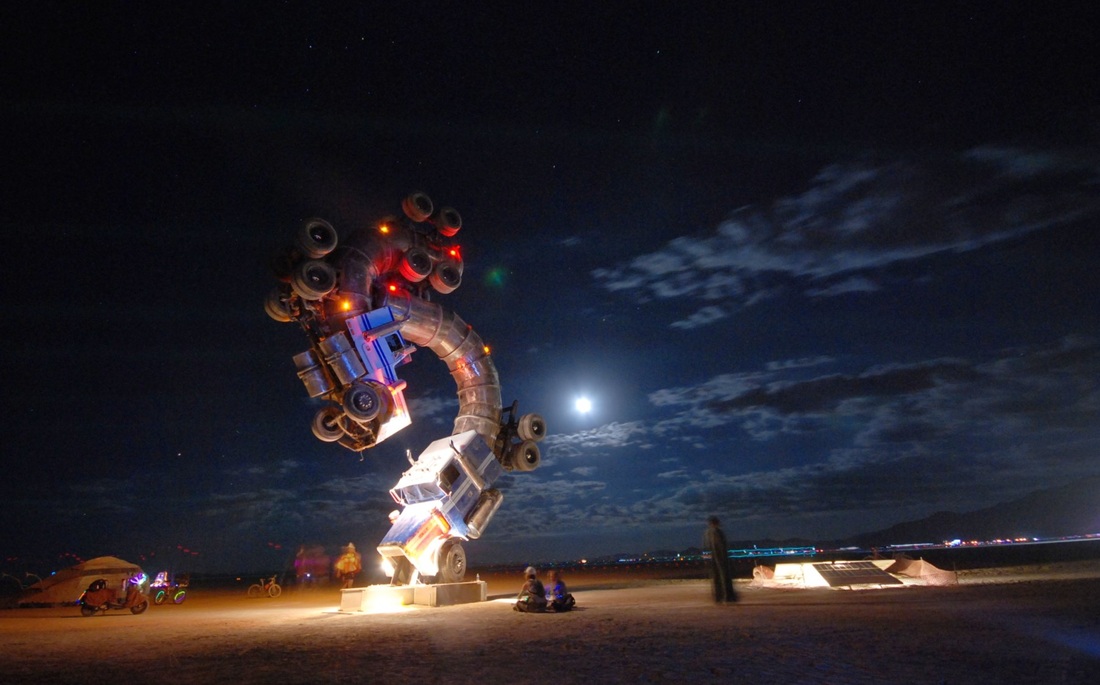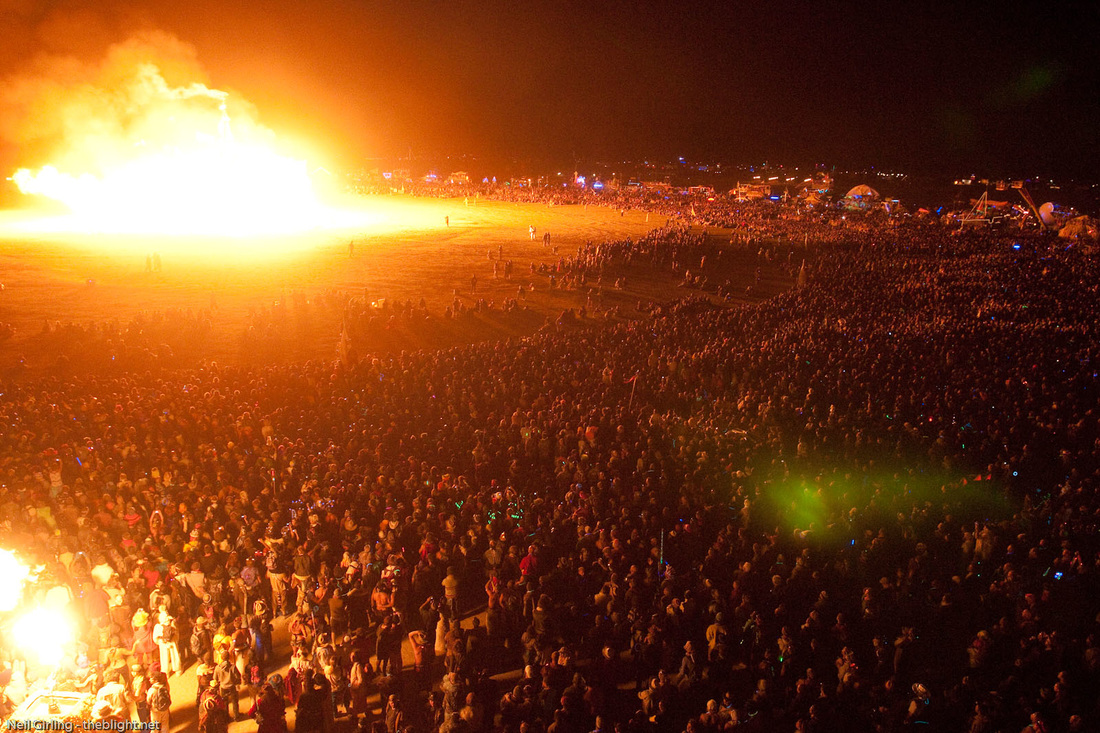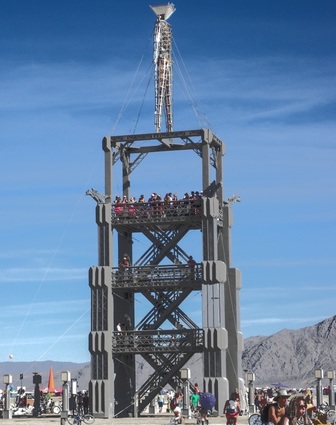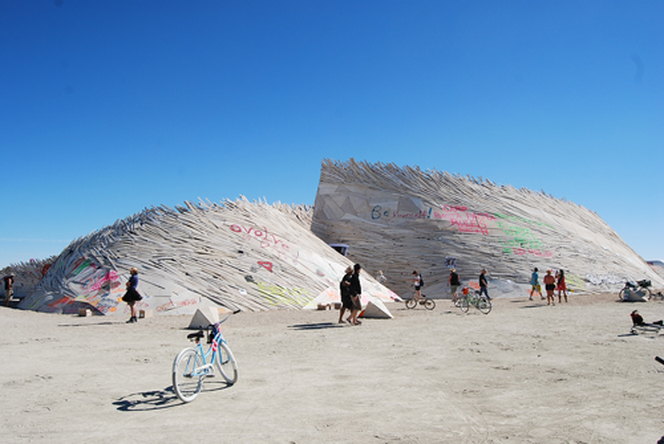|
|
By 2001, Burning Man roughly resembled what it is today, just less mainstreamed. The first (unofficial, but still clearly the first) Temple had appeared the year before, in 2000, and all the other major elements of Burning Man had been established at this point.
That doesn't mean that exciting and new times weren't ahead, but the event had hit really hit its stride by 2001 and while it's bigger today, it's days of radically changing from year to year were over by now. |
2001: Seven Ages
|
Population : 25,659
Man Height: 70 feet Ticket Cost: $200 |
|
|
Though it was much more pleasant at night than during the freezing 1999-2000 years, this year had its own challenges in the form of dust and a very soft surface, rendering thin-tired bikes fairly useless. This was also the first year that BMIR (Burning Man Information Radio) existed!
David Best and Jack Hayes came back again this year with the Mausoleum (also known as the Temple of Tears), and Burners covered its walls with messages, its altars with objects significant to the leaver, and more. This tradition has since become one of the core Burning Man traditions from year to year, with many (most perhaps?) of the writings and objects left intended as a memorial to someone who passed away in the last year. For many, it's difficult to visit the Temple and not get a little weepy. |
2001 also marked the first year I'm aware of that art was forced to be taken down at Burning Man. In this case, a camp called Jiffy Lube had a large sign of two men having sex outside their camp. Someone(s) complained and law enforcement got involved. There was a mediation session that failed to resolve the issue, and led to a protest parade to First Camp, at which point Larry Harvey came out and got involved. The camp and its defenders were unhappy because, at least ostensibly, they felt they were being discriminated against for homosexual art. Larry had wanted the person recording it to turn it off, as he didn't want what he was going to say on video, but happily the videographer ignored the request and filmed anyway. Here's the resulting video.
2002: The Floating World
Population : 28,979
Man Height: 80 feet
Ticket Cost: None
Man Height: 80 feet
Ticket Cost: None
Unlike the previous few years, 2002 had great weather with mild nights and a hard-packed playa surface, though according to the Burning Man timeline, a giant whiteout hit the cleanup crew after the event.
2003: Beyond Belief
Population : 30,586
Man Height: 79 feet
Man Height: 79 feet
Playa discipline! Photo: Nick DeWolf
2004: The Vault of Heaven
|
Population : 35,664
Man Height: 80 feet 2004 was a challenging year for many Burners as the weather was extreme. It swung from white-out dust storms to rain to very high temperatures and then cycled back again. In fact, according to the 2004 Afterburn report, 40 registered art projects didn't make it as planned due largely to the weather making them impossible to set up.
Most importantly for the future of the event, this was the year the Burning Man Project really began focusing on its regional network. As part of that work, Larry Harvey laid out the 10 Principles to help guide the culture of Regionals. It's important to remember this, in my opinion: The 10 Principles didn't exist as anything formal until 2004, and they were laid down as reflections of how the Burning Man operated at the time. They were not laid down as prescriptive hard and fast rules. Principles, not laws. These aren't the 10 Commandments or anything equivalent to them.
|
2005: Psyche
Population : 35,567
Man Height: 72 feet
Man Height: 72 feet
This was Burning Man's 20th anniversary! The difference between the first few years and now is gigantic, and a testament to the ability of its community to evolve from a few hundred people to tens of thousands. The weather was pleasant and people remember this year as a particularly good one.
2006: Hope and Fear
Population : 38,989
Man Height: 72 feet
Man Height: 72 feet
|
Another year that people talk about fondly, with generally good weather and no major snafus. The location of BRC was moved about a mile from previous years (first move since 2000) in order to let the BLM study the long-term effects, if any, of Burning Man on the playa.
Burning Man got its first tv station this year, after many years, of course, of BMIR and other radio stations out there. Current TV created TV Free Burning man, which produced news and video and broadcast back to defaultia via the internet. The very first Moop Map (see below) was published this year, and it is really bad by today's standards. Burners have gotten much better in the wake of the peer pressure that the published Moop Map creates, I think. |
|
From 2006 - 2008, the TV Free Burning Man project produced Emmy Award-nominated coverage of the Burning Man festival. All content was shot and edited on site, in real time, throughout the event. Here are 53 minutes of select coverage from all three years.
|
Holy shit! Look at all that yellow and red! Compare that to the 2014 Moop Map, for instance.
2007 - The Green MaN (Burns Twice)
Population : 47,097
Man Height: 72 feet
Man Height: 72 feet
|
Burning Man grew by almost 10,000 people this year. That's as many as the entire city had in 1997.
The biggest news to come out of 2007, though, was undoubtedly the early burning of the man by Paul Addis. Luckily, it wasn't fully destroyed and was rebuilt within 3 days, to then be burned as scheduled. There's a lot of conflicting opinions in the Burning Man community about Paul Addis (who went to jail for it and later committed suicide by jumping in front of a Bay Area Rapid Transit train). If you want to delve into the whole story, check out Scott Beale of the Laughing Squid's reporting on it. |
2008 - American Dream
Population : 49,599
Man Height: 90 feet
Man Height: 90 feet
This year's theme was oddly political for Burning Man where, perhaps unexpectedly, there's a bit of a cultural taboo against default-world political statements. As the population approached 50,000, Burning Man stopped selling tickets on-site at the Box Office for the first time ever, as a "way to deter unprepared participants and to monitor population growth. (quote from the Burning Man official timeline).
In terms of the event itself, the condition of the playa was awful, frequently stopping and trapping bikes and even mutant vehicles, plus the dreaded 'playa serpents', which are hard ridges of rippled playa that feel like they're shaking your teeth out of your head when you ride over them.
In terms of the event itself, the condition of the playa was awful, frequently stopping and trapping bikes and even mutant vehicles, plus the dreaded 'playa serpents', which are hard ridges of rippled playa that feel like they're shaking your teeth out of your head when you ride over them.
Peter Hudson's amazing 'Tantalus' zoetrope, which shows an apple, representing the American dream, being continually lifted above the hand that grasps for it.
2009 - Evolution
Population : 43,558
Man Height: 75 feet
Man Height: 75 feet
After the financial crisis of 2008, 2009 saw the population drop by about 7,000 people, and this year also saw the first-ever decline in the number of registered artworks being brought to the playa (215). It was, nonetheless, a good year with good weather and playa surface.
Burning Man 2010
Population : 51,525
Man Height: 104 feet
Man Height: 104 feet
|
As the economy picked back up, Burning Man did too, adding about 8,000 more people than last year and 275 registered art projects, up from 2009's 215. A couple streets - London and Mumbai - had to be added mid-week to support the population explosion. And, for the first time, the Department of Mutant Vehicles got over 1000 applications.
It also saw a hard rainstorm on opening day afternoon, resulting in the shutdown of all vehicle traffic. Unfortunately, it rained again during the playa clean-up effort, leading to the Playa Restoration crew having to slog through shin-deep playa mud while working. In order to reduce what had become pretty horrible Exodus lines, this was the first year they implemented traffic 'pulsing' where instead of inching forward every now and then, you can just stop your vehicle, get out, and then your line will be moved quite a lot every hour. It led to spontaneous one hour neighborhood parties and even cookouts during Exodus, which, if not making the wait times shorter, made them less annoying and sometimes even fun! |
A (poor quality) clip of Cthulhu destroying Burning Man, from a South Park episode in 2010.






